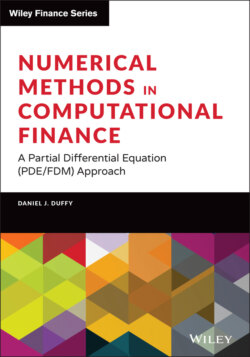Читать книгу Numerical Methods in Computational Finance - Daniel J. Duffy - Страница 35
2.2 BACKGROUND AND PROBLEM STATEMENT
ОглавлениеIn this section we introduce the very first differential equation of this book. It is a scalar first-order linear ordinary differential equation (ODE), and we shall analyse it from several qualitative and quantitative viewpoints.
Consider a bounded interval where . This interval could represent time or distance, for example. In most cases we shall view this interval as representing time values. In the interval we define the initial value problem (IVP) for an ODE:
(2.1)
where is a first-order linear differential operator involving the derivative with respect to the time variable and is a strictly positive function in . The term is called the inhomogeneous forcing term, and it is independent of . Finally, the solution to the IVP must be specified at ; this is the so-called initial condition.
In general, the problem (2.1) has a unique solution given by:
(2.2)
(See Hochstadt (1964), where the so-called integration factor is used to determine a solution.)
A special case of (2.1) is when the right-hand term is zero and is constant; in this case the solution becomes a simple exponential term without any integrals, and this will be used later when we examine difference schemes to determine their feasibility. In particular, a scheme that behaves badly for the above special case will be unsuitable for more general or more complex problems unless some modifications are introduced.
